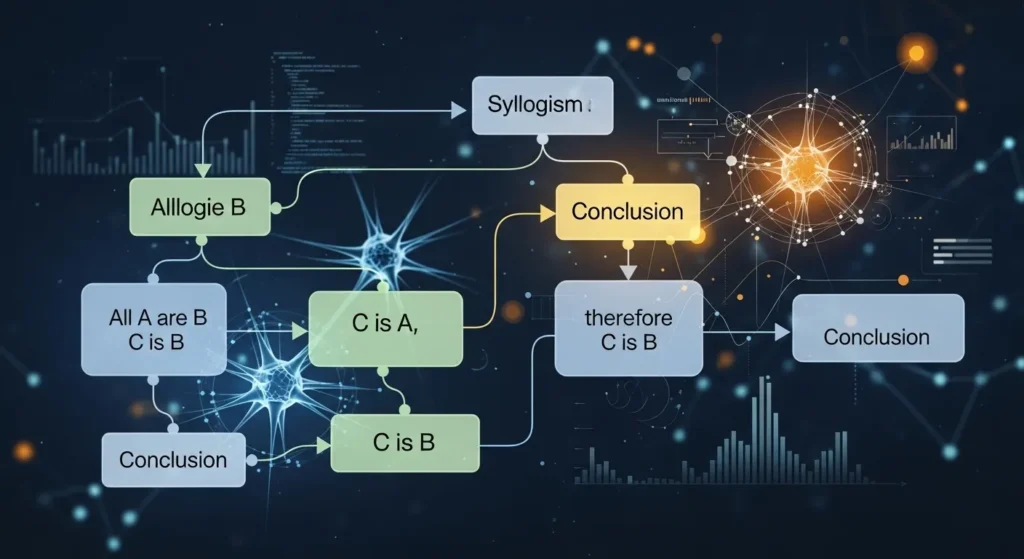- 1. Introduction: Why Logic Still Matters in AI
- 2. What Is a Syllogism Dataset?
- 3. The Connection Between Syllogism and Machine Learning
- 4. Key Syllogism Datasets Used in Research
- 5. How Researchers Use Syllogism Datasets
- 6. Results and Insights from Recent Studies
- 7. Building Your Own Syllogism Dataset (GitHub Approach)
- 8. Challenges and Future of Logic in Machine Learning
- 9. Conclusion
- FAQ: Syllogism Dataset Machine Learning
1. Introduction: Why Logic Still Matters in AI
Artificial intelligence is getting smarter every day, but true reasoning is still hard to achieve. That’s why researchers use the syllogism dataset machine learning approach — a method that helps AI models learn how to think logically instead of just recognizing patterns.
A syllogism is a simple logical argument, like: All humans are mortal. Socrates is human. Therefore, Socrates is mortal. While this seems easy for people, it’s actually complex for machines. Traditional machine learning systems often miss these logical links, which is why syllogism datasets are so valuable.
By training models on syllogism-based data, researchers can test whether AI can connect facts, draw valid conclusions, and reason like humans. In short, syllogism datasets in machine learning are helping transform how artificial intelligence understands logic and truth.
2. What Is a Syllogism Dataset?
A syllogism dataset is a structured collection of logic problems designed to test reasoning in AI. Each dataset includes premises (the facts), a conclusion, and a label showing whether the conclusion logically follows from the premises.
For example:
- Premise 1: All dogs are mammals.
- Premise 2: All mammals have hearts.
- Conclusion: All dogs have hearts. (True)
Datasets like this help researchers see how well AI handles syllogistic logic tasks. Traditional machine learning models often struggle with these because they rely on patterns, not understanding.
These datasets are key to improving logic-based AI training and reasoning performance benchmarks.
3. The Connection Between Syllogism and Machine Learning
Machine learning models process massive amounts of text to learn patterns. But logical reasoning goes deeper than language; it requires connecting facts correctly.
Modern large language models (LLMs), like GPT, try to improve this by learning through chain-of-thought reasoning, where the model explains its steps before giving an answer.
Understanding syllogisms helps AI go beyond text classification and move toward compositional reasoning, where it builds logical meaning from smaller parts. In simple terms, datasets help AI understand why something is true, not just that it is.
4. Key Syllogism Datasets Used in Research
Researchers use several major datasets to measure reasoning in AI systems:
NeuBAROCO Dataset
This dataset tests how belief bias affects AI logic. It studies whether models rely on logic or emotional belief when making conclusions.
ReClor Dataset
Focused on reading comprehension and reasoning, this dataset measures how well AI models understand relationships between facts.
LogicNLI Dataset
This dataset examines logical entailment tasks, deciding if one statement follows logically from another.
Many researchers also share open-source syllogism datasets on GitHub, making it easier for others to experiment and train AI reasoning evaluation models.
5. How Researchers Use Syllogism Datasets
Researchers train AI on these datasets to teach logical reasoning. They test models for inference and contradiction, seeing if the model can tell when something makes sense or not.
Syllogism datasets also help measure how cognitive bias in machine learning affects results. For example, an AI might favor an answer that “sounds true” but isn’t logical.
These experiments reveal where reasoning breaks down and guide developers to build better explainable reasoning in neural networks.
6. Results and Insights from Recent Studies
Recent studies show that GPT-style models perform better on reasoning benchmarks than older models, but they still make logical mistakes.
These mistakes often come from belief bias or atmosphere effects, where the wording of statements misleads the model.
Adding chain-of-thought reasoning improves accuracy because it encourages the AI to reason step by step. Still, even with these improvements, AI is not yet capable of true logical reasoning like a human.
7. Building Your Own Syllogism Dataset (GitHub Approach)
Creating your own syllogism dataset can be simple. Researchers often use Python and JSON files to structure premises and conclusions.
Here’s how you can start:
- Write a few logical statements and conclusions.
- Label each as “valid” or “invalid.”
- Save the data in a structured format.
- Upload it to GitHub or Hugging Face Datasets for others to test.
Open projects on GitHub often include scripts and examples for building reasoning datasets. These small datasets help evaluate how well models handle deductive reasoning and logic-based AI training.
8. Challenges and Future of Logic in Machine Learning
Even with great datasets, logical reasoning is tough for AI. Language is full of ambiguity; words can have many meanings.
Bias in datasets can also lead to incorrect reasoning. To fix this, researchers are combining symbolic and neural reasoning, mixing human-style logic with machine learning flexibility.
The future of logic-aware AI lies in explainable models that can clearly show why they reach a conclusion. This kind of transparent reasoning could improve AI systems in education, law, and science.
9. Conclusion
Syllogism datasets are teaching machines how to think logically. They show that true reasoning requires more than just language; it needs structure and understanding.
The quality of datasets like NeuBAROCO, ReClor, and LogicNLI helps push AI closer to real human-like logic.
In the future, as researchers build smarter and fairer datasets, we might finally see AI that reasons like humans, step by step, thought by thought.
FAQ: Syllogism Dataset Machine Learning
1. What is a syllogism in machine learning?
A syllogism uses two facts to form a conclusion. In machine learning, syllogism datasets help AI learn how to connect information logically.
2. Why do AI models need syllogism datasets?
They help test how well AI can think logically instead of just predicting words. It’s about reasoning, not memorizing.
3. What are some examples of syllogism datasets?
Common examples include NeuBAROCO, ReClor, and LogicNLI, all designed to test reasoning and belief bias in AI.
4. Can AI perform true logical reasoning like humans?
Not yet. AI can follow patterns and logic rules, but human reasoning is still more flexible and context-aware.
5. How does the NeuBAROCO dataset help in AI research?
It focuses on belief bias, helping researchers understand if AI relies on logic or intuition when making decisions.
6. How can developers create their own syllogism dataset?
They can build small datasets using Python and JSON, then share them on GitHub for others to study or expand.






